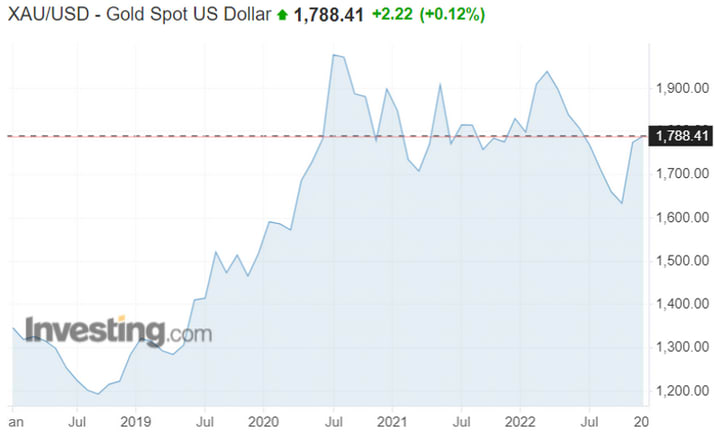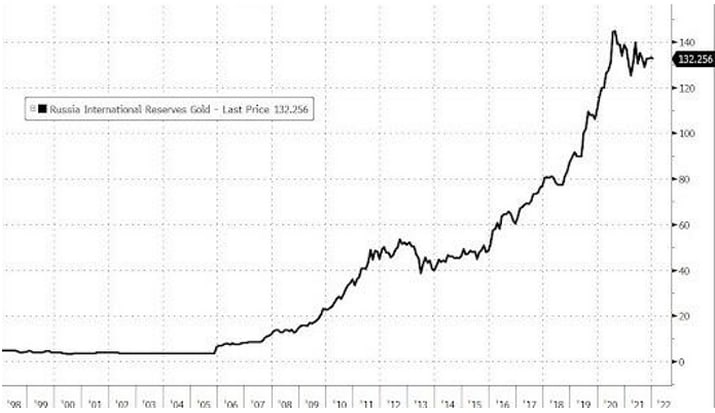The new sparkle of gold?

Professionals from the financial world have made a number of wild guesses and painted unprecedented scenarios for the price of gold for the upcoming year. Other analysts, on the other hand, expect the price of gold to fall next year.
Historically, gold has generally been seen as a hedge against inflation, but contrary to many expectations, its price did not rise when inflation started during the current year. Instead, its price has largely traded in the $1,600-$2,000 range over the past two years and is currently in the middle of the range, just under $1,800.

In part, gold's reputation as an inflation hedge held its own, as gold has clearly outperformed the S&P500 index this year.
Saxo's prediction for gold based on the war economy
Saxobank publishes its annual "Outrageous Predictions" list, and this time gold got into the limelight.
Saxo believes the price of gold will bounce to $3,000 as central banks fail with their inflation mandate. In other words, Saxo believes that next year will be the time when markets finally realize that inflation is here to stay.
According to Saxo, the market has made the mistake of pricing inflation as a temporary phenomenon, which has kept the price of gold in check when inflation is on the rise. Saxo asks: "how can you expect the price of gold to rise strongly against the dollar, if by investing in 5-year US-Treasury you can get a 4 percent return at a time when 5-year forward inflation is priced at 2.5 percent?"
The bank expects inflation to continue at a high level with these prospects. It expects China to give up the zero-tolerance line regarding Covid and thus demand will increase and cause a strong spike in commodity prices.
Saxo expects the "hardest of currencies" to receive support from three directions.
- As countries adopt a war economy mentality based on self-sufficiency, which minimizes foreign currency reserves and emphasizes gold ownership.
- Massive investments in national security priorities, which include energy sources, energy transmission and supply chains.
- Rising global liquidity as central banks avoid the economy drifting into recession.
Gold price down ten percent next year?
Specializing in raw materials Metals Focus, a British analysis house , on the other hand, believes that the price of gold will fall by ten percent next year. The firm believes that gold will reach its bottom in the last quarter of next year at the level of around $1,500.
In its analysis, Metals Focus says that the Fed's monetary policy and its effect on the US dollar will cause the worst headwind for precious metal prices next year. They expect the economy to weaken, and with record low unemployment, they believe the Fed will continue to pursue a hawkish monetary policy. This, the analyst house expects, will put pressure on risk investments in general, including gold and silver.
Despite this, Metals Focus sees gold as an important part of an investor's portfolio. They expect gold to outperform stocks and bonds.
The company expects low gold prices to support the demand for physical gold, which would create a stable base for the price of gold during the next year.
Petrogold
Credit Suisse commodity strategist Zoltan Pozsar, who is one of the most followed analysts on Wall Street, brings an interesting perspective to the gold debate.
Pozsar presents the idea of petrogold, where the price of oil would be pegged to the price of gold. The price capof 60 dollars set by the G7 countries for Russian oil corresponds to the price of one gram of gold at current market prices. If you think of this as a price peg, the G7 effectively pegs the US dollar to $60 a barrel of Ural oil. At the same time, Russia can peg the price of its barrel to the price of gold, where a gram of gold is equivalent to a barrel of oil from the Urals.
According to Pozsar, the money flows would change as follows:
- The US dollar will effectively be revalued in relation to Russian oil: "a barrel cheaper", but the price will be the loss of the global petrodollar position. If Western countries are looking for a discount, Russia can make an offer that is difficult for Western countries to refuse: "more for a gram".
If Russia responded to the $60 price peg by offering two barrels of oil for one gram of gold, the price of gold would double, or alternatively, the price of the dollar would weaken against the world's most important commodity immediately.
What does Russia get from this deal? It would not produce more oil, but it would ensure that there would be enough demand so that production would not have to be stopped. It would also ensure that more oil would go to Europe than through India to the United States.
And if the price of gold were to double from $1,800 to $3,600, it would increase the value of Russia's gold reserves, and increase gold mining both in Russia and in Africa.
Zoltan sums up his thoughts: “Crazy? Yes. Out? No. The current year has been full of unimaginable macroeconomic scenarios, and the government has returned to being the biggest force behind monetary policy decisions."
If Zoltan is right in his wild idea and Russia decides to peg the price of its oil to gold, it could bring back gold as a medium of exchange and greatly increase its intrinsic value.
Russian President Putin now has the power and ability to change the price of oil to the gold standard, which Russia and China have quietly prepared for. Russia has been hoarding a lot of gold in its reserves since the financial crisis.

How do you think the price of gold will develop in the future?
If your view is bullish and you believe the price of gold will rise, you have the opportunity to seek profits with Vontobel 's TLNG KULT V3-Turbo. At the time of writing, it offers 5x leverage on capital. If the price of the gold future increases by one percent, the value of the Turbo in question increases by five percent. When the price of gold drops by one percent, Turbo generates a five percent loss.
For a bear market, Vontobel 's TSRT KULT V242-Turbo offers a 4.09 times leveraged investment product for the pursuit of returns. If the price of gold futures decreases by one percent, Turbo makes a profit of 4.09 percent. If the price of the gold future goes up by one percent contrary to expectations, Turbo will suffer a loss of 4.09 percent.
Risks
External author:
This information is in the sole responsibility of the guest author and does not necessarily represent the opinion of Bank Vontobel Europe AG or any other company of the Vontobel Group. The further development of the index or a company as well as its share price depends on a large number of company-, group- and sector-specific as well as economic factors. When forming his investment decision, each investor must take into account the risk of price losses. Please note that investing in these products will not generate ongoing income.
The products are not capital protected, in the worst case a total loss of the invested capital is possible. In the event of insolvency of the issuer and the guarantor, the investor bears the risk of a total loss of his investment. In any case, investors should note that past performance and / or analysts' opinions are no adequate indicator of future performance. The performance of the underlyings depends on a variety of economic, entrepreneurial and political factors that should be taken into account in the formation of a market expectation.
Disclaimer:
This information is neither an investment advice nor an investment or investment strategy recommendation, but advertisement. The complete information on the trading products (securities) mentioned herein, in particular the structure and risks associated with an investment, are described in the base prospectus, together with any supplements, as well as the final terms. The base prospectus and final terms constitute the solely binding sales documents for the securities and are available under the product links. It is recommended that potential investors read these documents before making any investment decision. The documents and the key information document are published on the website of the issuer, Vontobel Financial Products GmbH, Bockenheimer Landstrasse 24, 60323 Frankfurt am Main, Germany, on prospectus.vontobel.com and are available from the issuer free of charge. The approval of the prospectus should not be understood as an endorsement of the securities. The securities are products that are not simple and may be difficult to understand. This information includes or relates to figures of past performance. Past performance is not a reliable indicator of future performance.
© Bank Vontobel Europe AG and/or its affiliates. All rights reserved.
